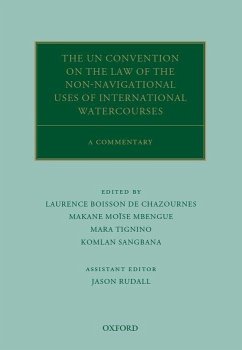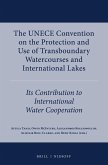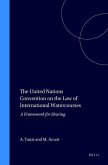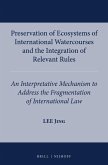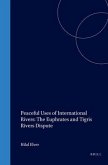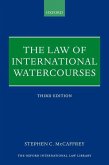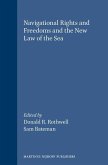Jason RudallA Commentary
The Un Convention on the Law of the Non-Navigational Uses of International Watercourses
A Commentary
Herausgeber: Boisson De Chazournes, Laurence; Sangbana, Komlan; Tignino, Mara; Mbengue, Makane Moïse
Jason RudallA Commentary
The Un Convention on the Law of the Non-Navigational Uses of International Watercourses
A Commentary
Herausgeber: Boisson De Chazournes, Laurence; Sangbana, Komlan; Tignino, Mara; Mbengue, Makane Moïse
- Gebundenes Buch
- Merkliste
- Auf die Merkliste
- Bewerten Bewerten
- Teilen
- Produkt teilen
- Produkterinnerung
- Produkterinnerung
The UN Watercourse Convention is crucial for the protection of fresh water sources. Examining the core principles applicable to water, the relationships between legal instruments, and the role of the courts in resolving disagreements, this book is a vital resource for all who seek a deep understanding of water law.
Andere Kunden interessierten sich auch für
![The Unece Convention on the Protection and Use of Transboundary Watercourses and International Lakes The Unece Convention on the Protection and Use of Transboundary Watercourses and International Lakes]() The Unece Convention on the Protection and Use of Transboundary Watercourses and International Lakes327,99 €
The Unece Convention on the Protection and Use of Transboundary Watercourses and International Lakes327,99 €![The United Nations Convention on the Law of International Watercourses The United Nations Convention on the Law of International Watercourses]() Attila TanziThe United Nations Convention on the Law of International Watercourses339,99 €
Attila TanziThe United Nations Convention on the Law of International Watercourses339,99 €![Preservation of Ecosystems of International Watercourses and the Integration of Relevant Rules Preservation of Ecosystems of International Watercourses and the Integration of Relevant Rules]() Lee JingPreservation of Ecosystems of International Watercourses and the Integration of Relevant Rules286,99 €
Lee JingPreservation of Ecosystems of International Watercourses and the Integration of Relevant Rules286,99 €![Peaceful Uses of International Rivers: The Euphrates and Tigris Rivers Dispute Peaceful Uses of International Rivers: The Euphrates and Tigris Rivers Dispute]() Hilal ElverPeaceful Uses of International Rivers: The Euphrates and Tigris Rivers Dispute256,99 €
Hilal ElverPeaceful Uses of International Rivers: The Euphrates and Tigris Rivers Dispute256,99 €![The Law of International Watercourses The Law of International Watercourses]() Stephen C MccaffreyThe Law of International Watercourses276,99 €
Stephen C MccaffreyThe Law of International Watercourses276,99 €![Navigational Rights and Freedoms and the New Law of the Sea Navigational Rights and Freedoms and the New Law of the Sea]() Navigational Rights and Freedoms and the New Law of the Sea309,99 €
Navigational Rights and Freedoms and the New Law of the Sea309,99 €![The 1997 UN Watercourses Convention and its Application The 1997 UN Watercourses Convention and its Application]() SAMUEL TADESSEThe 1997 UN Watercourses Convention and its Application35,99 €
SAMUEL TADESSEThe 1997 UN Watercourses Convention and its Application35,99 €-
-
-
The UN Watercourse Convention is crucial for the protection of fresh water sources. Examining the core principles applicable to water, the relationships between legal instruments, and the role of the courts in resolving disagreements, this book is a vital resource for all who seek a deep understanding of water law.
Hinweis: Dieser Artikel kann nur an eine deutsche Lieferadresse ausgeliefert werden.
Hinweis: Dieser Artikel kann nur an eine deutsche Lieferadresse ausgeliefert werden.
Produktdetails
- Produktdetails
- Verlag: Oxford University Press, USA
- Seitenzahl: 544
- Erscheinungstermin: 13. Februar 2019
- Englisch
- Abmessung: 249mm x 178mm x 36mm
- Gewicht: 1066g
- ISBN-13: 9780198778769
- ISBN-10: 0198778767
- Artikelnr.: 52404488
- Herstellerkennzeichnung
- Libri GmbH
- Europaallee 1
- 36244 Bad Hersfeld
- gpsr@libri.de
- Verlag: Oxford University Press, USA
- Seitenzahl: 544
- Erscheinungstermin: 13. Februar 2019
- Englisch
- Abmessung: 249mm x 178mm x 36mm
- Gewicht: 1066g
- ISBN-13: 9780198778769
- ISBN-10: 0198778767
- Artikelnr.: 52404488
- Herstellerkennzeichnung
- Libri GmbH
- Europaallee 1
- 36244 Bad Hersfeld
- gpsr@libri.de
Laurence Boisson de Chazournes is Professor of International Law at the University of Geneva. She is an adviser to various international organizations and governments, and has held international assignments as counsel, expert and arbitrator before the International Court of Justice (ICJ) and other judicial fora. Makane Moïse Mbengue is Associate Professor of International Law at the Faculty of Law of the University of Geneva. Mbengue is also an Affiliated Professor at Sciences Po Paris (School of Law), an adviser to several international organizations, and acts as counsel in disputes before international courts and tribunals. Mara Tignino, Reader at the Faculty of Law and the Institute for Environmental Sciences at the University of Geneva. She is the Coordinator of the Platform for International Water Law at the Geneva Water Hub. She obtained a PhD in international law from the Graduate Institute of International and Development Studies (Geneva) and was a Visiting Scholar at the George Washington University School of Law. She has published widely on issues related to international water law, such as the human right to water, the protection of water resources in times of armed conflict and the settlement of water disputes. She has served as an expert on international water law for various international organisations (UNITAR, the Inter-American Development Bank snd OSCE) and non-governmental organisations (WWF, Green Cross International). She was also a Legal Adviser in the International Court of Justice's case Pulp Mills on the Uruguay River. Komlan Sangbana is a Consultant with the UNECE Convention on the Protection and Use of Transboundary Watercourses and International Lakes. He is a member of the Platform for International Water Law. He obtained a PhD in international law from the Faculty of Law of University of Geneva. He was a Visiting Scholar at the Faculty of Law of the University of Edinburg. His research interests include the study of the rights and obligations on non-State actors in freshwater management, the protection of the environment and the functions and mandate of river basin organisations. Jason Rudall is a Researcher at the Faculty of Law of the University of Geneva and Programme Manager of the LL.M. in International Law at the Graduate Institute of International and Development Studies. He also holds a PhD in International Law from the Graduate Institute, Geneva.
* Preface
* Introduction: The Path to the UN Watercourses Convention and Beyond
* Section 1: Nature and Aims of the UN Watercourses Convention
* 1: S. Doumbe-Bille and F. Paccaud: The Choice of a Framework
Convention (Preamble)
* 2: M. Arcari: Scope of the Convention (Article 1)
* 3: A. Rieu-Clarke: Definitions and Use of Terms (Article 2)
* Section 2: The UN Watercourses Convention and other Fresh Water
Agreements
* 4: M.M. Mbengue: The Relationship between the Convention, Existing
and Future Fresh Water Agreements (Articles 3 and 4)
* Section 3: General Principles of the UN Watercourses Convention
* 5: L. Caflisch: Equitable and Reasonable Utilization and Factors
Relevant to Determining Such Utilization (Articles 5 and 6)
* 6: S.M.A. Salman: The Obligation not to Cause Significant Harm
(Article 7)
* 7: C. Leb: General Obligation to Cooperate and Regular Exchange of
Data and Information (Articles 8 and 9)
* 8: L. del Castillo-Laborde: Relationship between Different Kinds of
Uses (Article 10)
* Section 4: Planned Measures
* 9: K. Sangbana: Notification and Consultation Concerning Planned
Measures (Articles 11-19)
* Section 5: Protection, Preservation and Management
* 10: O. McIntyre: Protection and Preservation of Freshwater Ecosystems
(Articles 20-23)
* 11: D. Ziganshina: Management (Article 24)
* 12: T. Henshaw and R. Paisley: Regulation (Article 25)
* 13: D. Azaria: Installations (Article 26)
* Section 6: Harmful Conditions and Emergency Situations
* 14: R. Moynihan and B.-O. Magsig: Prevention and Mitigation of
Harmful Conditions and Emergency Situations (Articles 27 and 28)
* Section 7: Miscellaneous Provisions
* 15: M. Tignino: International Watercourses and Installations in Time
of Armed Conflicts; the Obligation of Cooperation and Indirect
Procedures; Exchange of Information and Protection of Data and
Information Vital to National Defence or Security (Articles 29-31)
* 16: R. Greco: Access to Procedures and the Principle of
Non-Discrimination (Article 32)
* Section 8: Prevention and Settlement of Disputes
* 17: A. Tanzi and G.M. Farnelli: The Settlement of Disputes through
Non-Judicial Means (Article 33.1-33.9)
* 18: L. Boisson de Chazournes: The Settlement of Disputes through
Judicial Means (Article 33.10 and the Annex on Arbitration)
* Section 9: The UN Watercourses Convention and Instruments Dealing
with the Management and Protection of Fresh Water Resources
* 19: F. Sindico and L. Movilla: The Interplay between the UN
Watercourses Convention and the Law on Transboundary Aquifers
(Article 2)
* 20: J.G. Lammers: The Interplay between the UN Watercourses
Convention and the UNECE Convention on the Protection and Use of
Transboundary Watercourses and International Lakes
* 21: J. Rudall: The Interplay between the UN Watercourses Convention
and International Environmental Law
* 22: B. McGarry: The UN Watercourses Convention and International
Economic Law
* Appendix: Convention on the Law of the Non-Navigational Uses of
International Watercourses
* Analytical Index
* Introduction: The Path to the UN Watercourses Convention and Beyond
* Section 1: Nature and Aims of the UN Watercourses Convention
* 1: S. Doumbe-Bille and F. Paccaud: The Choice of a Framework
Convention (Preamble)
* 2: M. Arcari: Scope of the Convention (Article 1)
* 3: A. Rieu-Clarke: Definitions and Use of Terms (Article 2)
* Section 2: The UN Watercourses Convention and other Fresh Water
Agreements
* 4: M.M. Mbengue: The Relationship between the Convention, Existing
and Future Fresh Water Agreements (Articles 3 and 4)
* Section 3: General Principles of the UN Watercourses Convention
* 5: L. Caflisch: Equitable and Reasonable Utilization and Factors
Relevant to Determining Such Utilization (Articles 5 and 6)
* 6: S.M.A. Salman: The Obligation not to Cause Significant Harm
(Article 7)
* 7: C. Leb: General Obligation to Cooperate and Regular Exchange of
Data and Information (Articles 8 and 9)
* 8: L. del Castillo-Laborde: Relationship between Different Kinds of
Uses (Article 10)
* Section 4: Planned Measures
* 9: K. Sangbana: Notification and Consultation Concerning Planned
Measures (Articles 11-19)
* Section 5: Protection, Preservation and Management
* 10: O. McIntyre: Protection and Preservation of Freshwater Ecosystems
(Articles 20-23)
* 11: D. Ziganshina: Management (Article 24)
* 12: T. Henshaw and R. Paisley: Regulation (Article 25)
* 13: D. Azaria: Installations (Article 26)
* Section 6: Harmful Conditions and Emergency Situations
* 14: R. Moynihan and B.-O. Magsig: Prevention and Mitigation of
Harmful Conditions and Emergency Situations (Articles 27 and 28)
* Section 7: Miscellaneous Provisions
* 15: M. Tignino: International Watercourses and Installations in Time
of Armed Conflicts; the Obligation of Cooperation and Indirect
Procedures; Exchange of Information and Protection of Data and
Information Vital to National Defence or Security (Articles 29-31)
* 16: R. Greco: Access to Procedures and the Principle of
Non-Discrimination (Article 32)
* Section 8: Prevention and Settlement of Disputes
* 17: A. Tanzi and G.M. Farnelli: The Settlement of Disputes through
Non-Judicial Means (Article 33.1-33.9)
* 18: L. Boisson de Chazournes: The Settlement of Disputes through
Judicial Means (Article 33.10 and the Annex on Arbitration)
* Section 9: The UN Watercourses Convention and Instruments Dealing
with the Management and Protection of Fresh Water Resources
* 19: F. Sindico and L. Movilla: The Interplay between the UN
Watercourses Convention and the Law on Transboundary Aquifers
(Article 2)
* 20: J.G. Lammers: The Interplay between the UN Watercourses
Convention and the UNECE Convention on the Protection and Use of
Transboundary Watercourses and International Lakes
* 21: J. Rudall: The Interplay between the UN Watercourses Convention
and International Environmental Law
* 22: B. McGarry: The UN Watercourses Convention and International
Economic Law
* Appendix: Convention on the Law of the Non-Navigational Uses of
International Watercourses
* Analytical Index
* Preface
* Introduction: The Path to the UN Watercourses Convention and Beyond
* Section 1: Nature and Aims of the UN Watercourses Convention
* 1: S. Doumbe-Bille and F. Paccaud: The Choice of a Framework
Convention (Preamble)
* 2: M. Arcari: Scope of the Convention (Article 1)
* 3: A. Rieu-Clarke: Definitions and Use of Terms (Article 2)
* Section 2: The UN Watercourses Convention and other Fresh Water
Agreements
* 4: M.M. Mbengue: The Relationship between the Convention, Existing
and Future Fresh Water Agreements (Articles 3 and 4)
* Section 3: General Principles of the UN Watercourses Convention
* 5: L. Caflisch: Equitable and Reasonable Utilization and Factors
Relevant to Determining Such Utilization (Articles 5 and 6)
* 6: S.M.A. Salman: The Obligation not to Cause Significant Harm
(Article 7)
* 7: C. Leb: General Obligation to Cooperate and Regular Exchange of
Data and Information (Articles 8 and 9)
* 8: L. del Castillo-Laborde: Relationship between Different Kinds of
Uses (Article 10)
* Section 4: Planned Measures
* 9: K. Sangbana: Notification and Consultation Concerning Planned
Measures (Articles 11-19)
* Section 5: Protection, Preservation and Management
* 10: O. McIntyre: Protection and Preservation of Freshwater Ecosystems
(Articles 20-23)
* 11: D. Ziganshina: Management (Article 24)
* 12: T. Henshaw and R. Paisley: Regulation (Article 25)
* 13: D. Azaria: Installations (Article 26)
* Section 6: Harmful Conditions and Emergency Situations
* 14: R. Moynihan and B.-O. Magsig: Prevention and Mitigation of
Harmful Conditions and Emergency Situations (Articles 27 and 28)
* Section 7: Miscellaneous Provisions
* 15: M. Tignino: International Watercourses and Installations in Time
of Armed Conflicts; the Obligation of Cooperation and Indirect
Procedures; Exchange of Information and Protection of Data and
Information Vital to National Defence or Security (Articles 29-31)
* 16: R. Greco: Access to Procedures and the Principle of
Non-Discrimination (Article 32)
* Section 8: Prevention and Settlement of Disputes
* 17: A. Tanzi and G.M. Farnelli: The Settlement of Disputes through
Non-Judicial Means (Article 33.1-33.9)
* 18: L. Boisson de Chazournes: The Settlement of Disputes through
Judicial Means (Article 33.10 and the Annex on Arbitration)
* Section 9: The UN Watercourses Convention and Instruments Dealing
with the Management and Protection of Fresh Water Resources
* 19: F. Sindico and L. Movilla: The Interplay between the UN
Watercourses Convention and the Law on Transboundary Aquifers
(Article 2)
* 20: J.G. Lammers: The Interplay between the UN Watercourses
Convention and the UNECE Convention on the Protection and Use of
Transboundary Watercourses and International Lakes
* 21: J. Rudall: The Interplay between the UN Watercourses Convention
and International Environmental Law
* 22: B. McGarry: The UN Watercourses Convention and International
Economic Law
* Appendix: Convention on the Law of the Non-Navigational Uses of
International Watercourses
* Analytical Index
* Introduction: The Path to the UN Watercourses Convention and Beyond
* Section 1: Nature and Aims of the UN Watercourses Convention
* 1: S. Doumbe-Bille and F. Paccaud: The Choice of a Framework
Convention (Preamble)
* 2: M. Arcari: Scope of the Convention (Article 1)
* 3: A. Rieu-Clarke: Definitions and Use of Terms (Article 2)
* Section 2: The UN Watercourses Convention and other Fresh Water
Agreements
* 4: M.M. Mbengue: The Relationship between the Convention, Existing
and Future Fresh Water Agreements (Articles 3 and 4)
* Section 3: General Principles of the UN Watercourses Convention
* 5: L. Caflisch: Equitable and Reasonable Utilization and Factors
Relevant to Determining Such Utilization (Articles 5 and 6)
* 6: S.M.A. Salman: The Obligation not to Cause Significant Harm
(Article 7)
* 7: C. Leb: General Obligation to Cooperate and Regular Exchange of
Data and Information (Articles 8 and 9)
* 8: L. del Castillo-Laborde: Relationship between Different Kinds of
Uses (Article 10)
* Section 4: Planned Measures
* 9: K. Sangbana: Notification and Consultation Concerning Planned
Measures (Articles 11-19)
* Section 5: Protection, Preservation and Management
* 10: O. McIntyre: Protection and Preservation of Freshwater Ecosystems
(Articles 20-23)
* 11: D. Ziganshina: Management (Article 24)
* 12: T. Henshaw and R. Paisley: Regulation (Article 25)
* 13: D. Azaria: Installations (Article 26)
* Section 6: Harmful Conditions and Emergency Situations
* 14: R. Moynihan and B.-O. Magsig: Prevention and Mitigation of
Harmful Conditions and Emergency Situations (Articles 27 and 28)
* Section 7: Miscellaneous Provisions
* 15: M. Tignino: International Watercourses and Installations in Time
of Armed Conflicts; the Obligation of Cooperation and Indirect
Procedures; Exchange of Information and Protection of Data and
Information Vital to National Defence or Security (Articles 29-31)
* 16: R. Greco: Access to Procedures and the Principle of
Non-Discrimination (Article 32)
* Section 8: Prevention and Settlement of Disputes
* 17: A. Tanzi and G.M. Farnelli: The Settlement of Disputes through
Non-Judicial Means (Article 33.1-33.9)
* 18: L. Boisson de Chazournes: The Settlement of Disputes through
Judicial Means (Article 33.10 and the Annex on Arbitration)
* Section 9: The UN Watercourses Convention and Instruments Dealing
with the Management and Protection of Fresh Water Resources
* 19: F. Sindico and L. Movilla: The Interplay between the UN
Watercourses Convention and the Law on Transboundary Aquifers
(Article 2)
* 20: J.G. Lammers: The Interplay between the UN Watercourses
Convention and the UNECE Convention on the Protection and Use of
Transboundary Watercourses and International Lakes
* 21: J. Rudall: The Interplay between the UN Watercourses Convention
and International Environmental Law
* 22: B. McGarry: The UN Watercourses Convention and International
Economic Law
* Appendix: Convention on the Law of the Non-Navigational Uses of
International Watercourses
* Analytical Index

